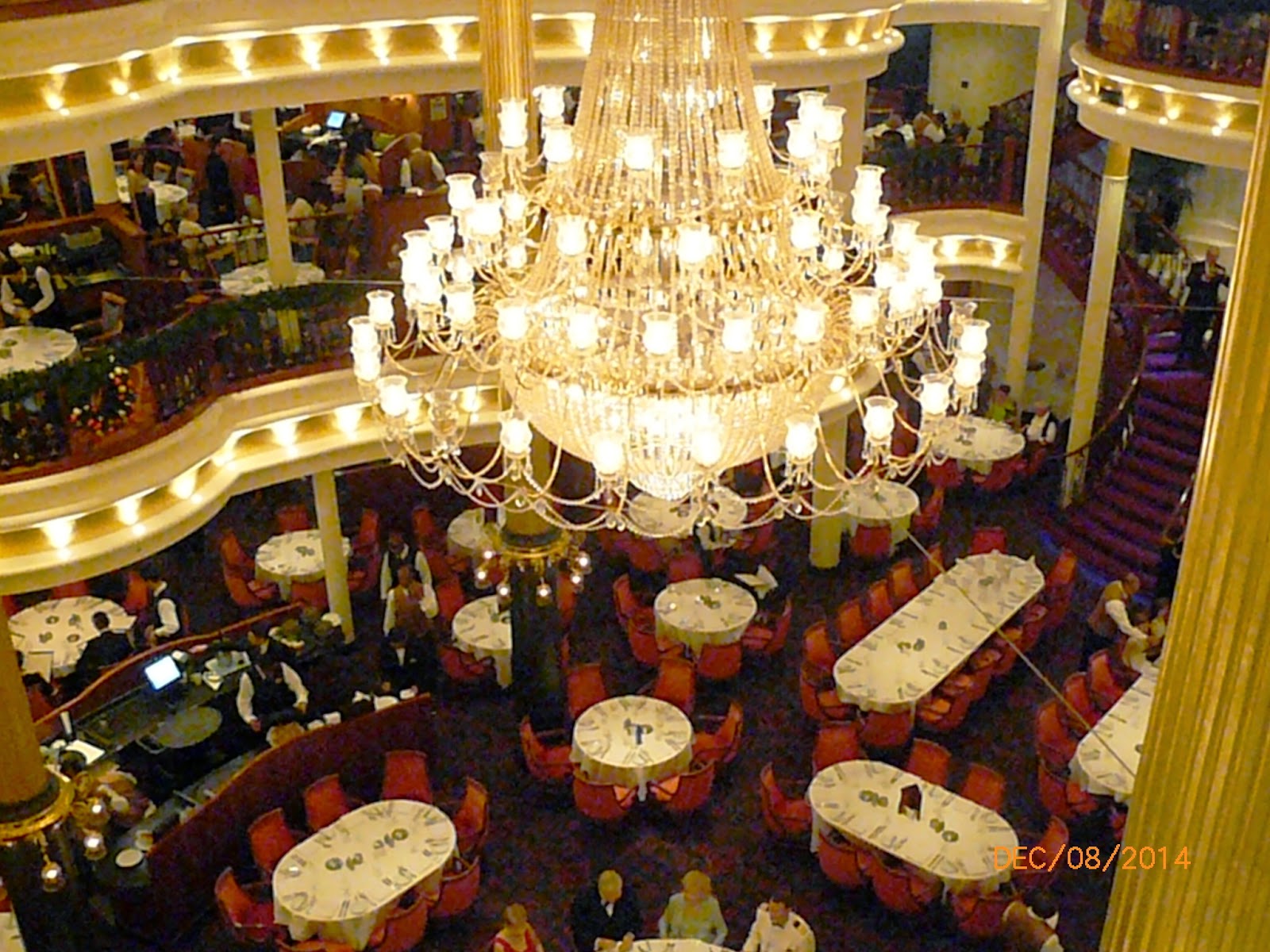This is the first time ever we have gone on a cruise. We kind of spoiled ourselves with the ship we went on. This is the Freedom of the Seas. MS Freedom of the Seas is a cruise ship operated by Royal Caribbean International. It is the namesake of Royal Caribbean's Freedom class, and can accommodate 3,634 passengers and 1,300 crew on fifteen passenger decks. Freedom of the Seas was the largest passenger ship ever built (by gross tonnage) from 2006 until construction of the Royal Caribbean International's Oasis-class ships in late 2009.
To give you an idea of how big this ship is, this is a picture of the promenade deck. It is 5 decks high and runs from the front of the ship to the back and is filled with jewellery shops, liquor stores, cafes, and all kinds of souvenir shops. It is virtually a small town built into this ship. At nights they have parades and all kinds of music entertainment to enjoy.
Here we have a picture of our state room from the balcony. The rooms are a little small but very well kept and clean. The service here is phenomenal as they come in 2 times a day to clean and keep things tidy. Each night after 6 pm they leave a list of the activities that are going on around the ship for the next day and believe me there is no shortage of activities and shopping on this ship.
 As we leave the port we managed to get some pics of the coastline of Cape Canaveral and while heading out to sea the sunset was spectacular. When you are standing on the top deck of this ship you can see miles and miles.
As we leave the port we managed to get some pics of the coastline of Cape Canaveral and while heading out to sea the sunset was spectacular. When you are standing on the top deck of this ship you can see miles and miles. On the third day of our cruise we arrived in Labadee, Labadee is a port located on the northern coast of Haiti. It is a private resort leased to Royal Caribbean International until 2050 Royal Caribbean International has contributed the largest proportion of tourist revenue to Haiti since 1986, employing 300 locals, allowing another 200 to sell their wares on the premises for a fee and paying the Haitian government US$6 per tourist.
The resort is completely tourist-oriented, and is guarded by a private security force. The site is fenced off from the surrounding area, and passengers are not allowed to leave the property. Food available to tourists is brought from the cruise ships. A controlled group of Haitian merchants are given sole rights to sell their merchandise and establish their businesses in the resort. Although sometimes described as an island in advertisements, it is actually a peninsula contiguous with the island of Hispaniola. The cruise ship moors to the pier at Labadee capable of servicing the Oasis class ships, which was completed in late 2009.
Attractions include a Haitian flea market, beaches, watersports, a water-oriented playground, a roller-coaster-type ride, and a zip-line. The zip line is the largest in the world over open water.
There are 2 formal nights where you have to get dressed up to go to dinner. Here we have a picture of us just before going to dinner on the first formal night. This pic was taken on the balcony of our state room with the Atlantic ocean as the backdrop.
The dining rooms are located on three levels and open in the middle overlooking the Captains table. The tables are made up very elegantly and the food was also elegant.

On the fourth day of our cruise we arrived in Falmouth. Falmouth is the chief town and capital of the parish of Trelawny in Jamaica. It is situated on Jamaica's north coast 18 miles east of Montego Bay. It is noted for being one of the Caribbean's best-preserved Georgian town. Falmouth flourished as a market centre and port for forty years at a time when Jamaica was the world's leading sugar producer.
The town was meticulously planned from the start, with wide streets in a regular grid, adequate water supply, and public buildings. It even had piped water before New York City. Falmouth was one of the busiest ports in Jamaica. It was home to masons, carpenters, tavern-keepers, mariners, planters and others. It was a wealthy town in a wealthy parish with a rich racial mix. Within the parish, nearly one hundred plantations were actively manufacturing sugar and rum for export to Britain. Jamaica, during this period, had become the world's leading sugar producer.
All the above made Falmouth a central hub of the slave trade and the now notorious cross-Atlantic triangular trade, with its economy largely based on slavery. In Falmouth Harbour as many as 30 tall-ships could be seen on any given day, many of them delivering slaves transported under inhumane conditions from Africa and loading their holds with rum and sugar manufactured by slave labour on nearby plantations.
As a result, starting in 1840, Falmouth's fortunes as a commercial centre declined after the emancipation of slaves in the British Empire. This decline and lack of support for development has left many of its early buildings standing.

While in Jamaica we were fortunate enough to be able to take in some of the local beauty that this Island has to offer. They have a very large variety of beautiful and exotic birds also a vast array of marine life. We got to see a dolphin show and watched the sharks being fed.

On the fifth day our next port of call was in Georgetown,
George Town is a city situated on the Grand Cayman island of the Cayman Islands. It serves as the capital of the Cayman Islands, in the British West Indies. As of 2007, the city had a population of 28,836, making it the second largest city (by population) of all the British Overseas Territories.
George Town is the heart of the Cayman Islands financial industry, there are close to 600 Bank and Trust companies in the Cayman Islands. George Town's city limits extend from the east at the edge of the South Shore District, north just beyond Owen Roberts International Airport, south to Hog Sty Bay and west to Seven Mile Beach and the West Bay District. George Town's famous Seven Mile Beach is a long crescent of coral-sand beach extending up to the West Bay region of Grand Cayman and is the most popular and populated area for tourists on the island.
In Georgetown, they do not have a port to dock any of the cruise liners so the ships dock in the bay. All passengers are ferried back and fourth into town by smaller boats. At times you can see as many as 5 cruise ships docked in the bay and just imagine getting over 20,000 passengers into town and then back on the ships again every time these ships pull into the harbor.
Our fourth port was suppose to be Cozumel, Mexico but after we left the Cayman Islands there was a medical emergency of a 9 month old baby girl and the ship and to be returned to Georgetown where the little girl was hospitalized and then flown to Miami. The ships also had some mechanical issues so the ship was running at reduced speed so the time could not be made up in order to get to the island of Cozumel. But on our way back to Port Canaveral we did catch a glimpse of Miami at sunset and it was beautiful.

.jpg)



































